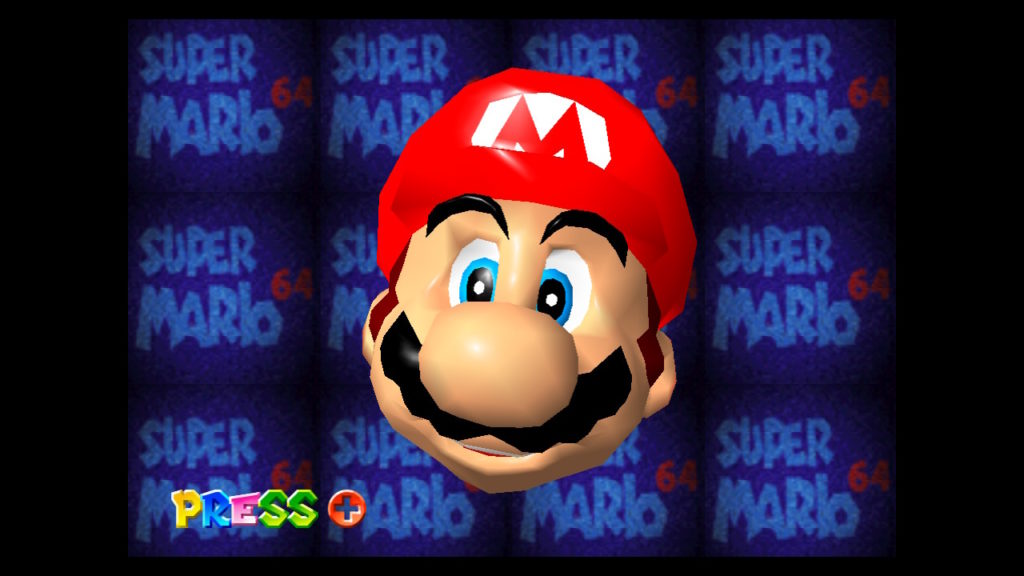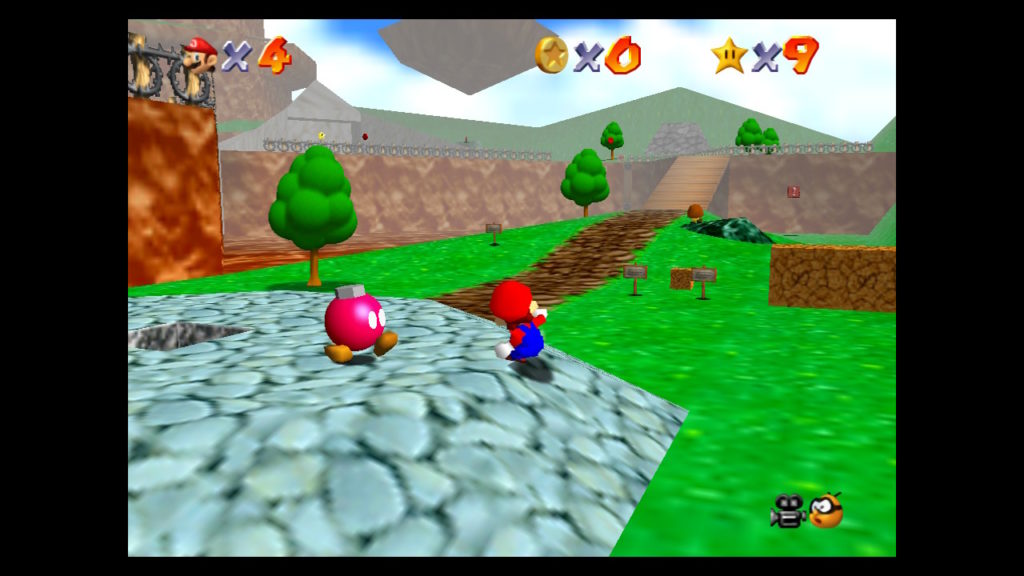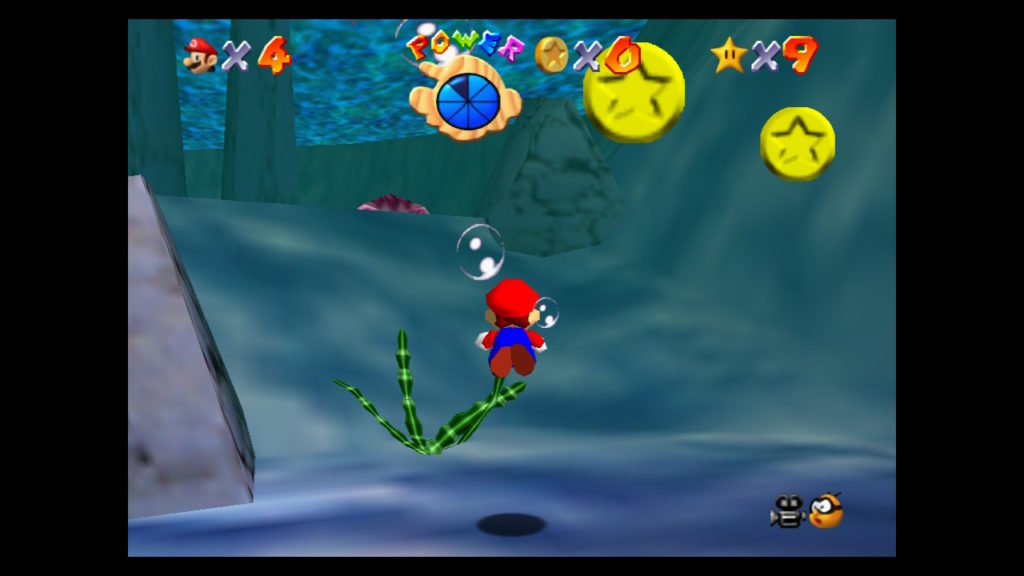Super Mario 64 was not the first true 3-D graphical game I ever played, but it was the first to use that environment to its potential. Instead of Mario 64, it should have been called Mario 3D, because 64-bit graphics didn’t even mean anything anymore after this one—gaming was no longer about seeing the world but living in it.

This was not the first Nintendo 64 game my brothers and I owned but it was one of the first. Even the process of buying it was new: none of us wanted to fully front even the on-sale price of $40, so we all went in together and bought shares of it. Whose was it? Well, everyone’s, supposedly. But it was mostly mine—I put in about half the money, and my brothers split the rest. I didn’t care; I just wanted to play it.

I didn’t even play at first, though—somehow that honor always goes to the firstborn. We powered the system up and started pushing buttons. The opening of the game, set outside Peach’s Castle in the idyllic Mushroom Kingdom, looked good at first, but the graphics weren’t all that incredible and I wondered immediately if I’d made a mistake tossing my $20 into the hat. The game initially seemed obsessed with introducing the role of the omnipresent cameraman Lakitu and I wondered when camera explanations would vanish and we could jump into jumping Koopas. I didn’t understand it at the time, but this marked just how innovative the game was—Nintendo felt they had to explain to the players exactly how they could even see Mario’s new 3D realm. At first, I scoffed: outside and inside the Mushroom Castle was cool and all, but it felt small and closed, so the 3-D graphics didn’t really matter.

Then we jumped through a painting of Bob-ombs and Lakitu’s view suddenly blew my mind. For the first five or ten minutes of watching gameplay, I couldn’t even understand what I was looking at. It had an out-of-body experience where my eyes inhabited a dynamic, polygonal world and my brain refused to process it properly and instead spit out question marks. You could go here—or there—or over there. It was overwhelming; how were we supposed to know where to go? I don’t get motion sickness playing video games, ever, but this one initially tossed me something analogous. It was almost terrifying that there seemed to be no restrictions: you could go up, down, around; kick off walls, ride on shells, stomp baddies, collect coins, shove a boss off a hill, fly through the sky. It was only years later I realized how small these levels really were, but they were cleverly created to encompass an entire mental world. Anywhere you went was acceptable: X and Y had found Z. The world was alive, and my character, for the first time, unlimited.

Super Mario 64 had much more than looks. It was fun, too: its gameplay was phenomenal. I remember after we bought the game we steeled ourselves for the long ride home. The best way to pass that kind of time was always to open the box of whatever toy or game you’d gotten at Toys R Us or Walmart, so you could read the manual on the way home. In reading this thing, I kept turning the page and marveling at the number of moves Mario had acquired in his time off after leaving Super Mario World. Clearly, he’d been working out and could now punch, kick, triple jump, flip, wall jump, pound the ground, or swim like a dolphin. Not only that but his new hats held new moves and new magic. Mario had kept his platforming roots while transforming into one of the greatest emblems of the adventure genre before our eyes.

Confession: before this one, I had never been a huge fan of the true Mario platformers. There was a reason Super Mario 64 wasn’t our first Nintendo 64 game. We’d never purchased Super Mario World, or Super Mario Bros. 1 or 3 (in fairness, we didn’t grow up with a household NES). I mean, Super Mario Land 2 was fun (if short), Wario Land was kind of great, and Super Mario World wasn’t bad at all. But Super Marios 1, 2, and 3 had never really done for me what they’d seemed to do for everybody else, and the arcade Donkey Kong and Mario Bros. games flat-out sucked. But Mario in Super Mario 64 had moved from a side-scrolling 2-D hopping mannequin into a full-fledged human hero. The sheer variety of maneuvers, for a game from 1996, was unparalleled. Just how fun it was to slide down a mountain holding half a snowman for an impromptu family reunion—well, they got all the gameplay right in this one.

The snowy slides were fun, and so were the bright sunny fields, the lava lands, the sandy deserts, the innards of the giant grandfather clock, the rainbow voyage through the skies, and everywhere in between. Every world was visually, aurally, and stylistically so unique: that was a thing in adventure gaming both before (Super Mario 3, Sonic the Hedgehog…) and after this game (Donkey Kong 64, Zelda: Ocarina of Time, Super Mario Galaxy…), but I believe no other game before lit the world up as brightly as this one, with every world an entire dimension removed from its neighboring land. Like the single-colored rooms of the palace in Poe’s “The Masque of the Red Death,” Mario’s new worlds were distinct, memorable, and deadly—nothing vague or fuzzy there at all.

Just as memorable as the visuals was the soundtrack. My kid and I have hopped and pranced around to this music many times, and I still think the “Dire Dire Docks/Jolly Roger Bay” track represents some of the best video game music ever composed. The heights Shigeru Miyamoto managed for the game production were equaled by Koji Kondo’s unforgettable aural landscapes.

Here’s to Super Mario 64, my very favorite game for the better part of almost 30 years. It could have been number one on this list, but like anything on the Nintendo 64, it’s slightly creaky with age. Still, if you play it now, even with that original (read: horrific) N64 controller, you’ll see the same magic that reorganized my gray matter when we first popped it into the console.